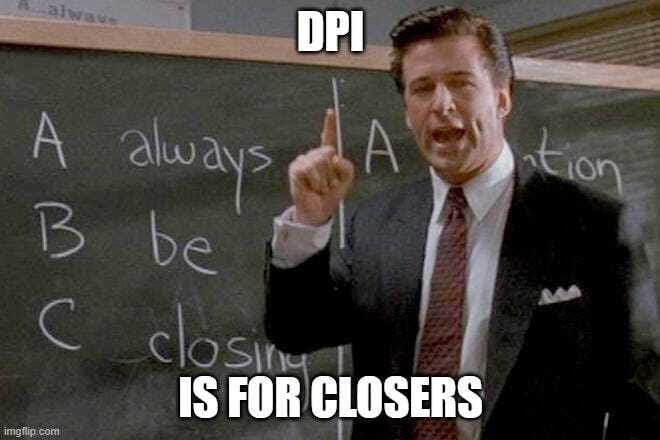
We all know that bad data in = bad data out.
When contract data is unstructured, everything downstream suffers.Manual billing and invoices, messy spreadsheets, and hours of reconciliation that never quite tie out.
Tabs fixes that.
We’re the AI-native revenue platform that automates the entire contract-to-cash cycle. Whether you're selling custom terms, usage-based pricing, or a mix of PLG and sales-led, Tabs turns month-end chaos into clean cash flow.
✅ Instantly generates invoices and revenue schedules from complex contracts✅ Automates dunning, revenue recognition, and cash application✅ Syncs clean, structured data across your ERP and reporting stack
Trusted by companies like Cortex, Statsig, and Cursor, Tabs powers the finance teams behind the next wave of category leaders.

The Metrics That Matter to Investors: IRR, TVPI, DPI Explained
1. IRR (Internal Rate of Return): The Speedometer
IRR reflects the annualized return an investment generates, considering the time value of money. An IRR of 18% means a $1 investment grows to $1.18 annually, compounded.
But here’s the nuance: IRR is sensitive to when cash comes back. Early wins inflate IRR. Late ones deflate it. That’s why timing games matter.
2. TVPI (Total Value to Paid-In) or MoM (Multiple of Money): The Dream
TVPI = (Distributions + Residual Value) / Invested Capital.
A TVPI of 2.4x means the fund has marked the investment at 2.4x what it put in. If you invested $25M, it’s now "worth" $60M on paper.
But paper is just that—paper. TVPI includes unrealized gains. It reflects how investors estimate the story to unfold.
3. DPI (Distributions to Paid-In): The Bank Account
DPI = Realized Returns / Invested Capital
If DPI is 0.5x on a $100M fund, only $50M has come home to date. DPI is cold, hard cash back to LPs. It's the only thing you can spend.
TVPI is for dreamers. DPI is for people who want to buy houses and jet skis.
4. RVPI (Remaining Value to Paid-In): What’s Left in the Oven
RVPI = TVPI - DPI. It’s the unrealized piece that’s still baking. Important for valuations. But until there’s a sale, it’s just marked to market.

The gold Remaining Value Paid In (RVPI) in the chart above is the “unrealized” portion that’s marked to market on paper but not yet in a bank account. The blue portions of the bar are the distributions you’ve harvested. And eventually it all becomes blue. TVPI is the total, labeled in grey.
In perpetuity, your DPI should catch up to your TVPI (or MoM).
As someone who worked in the valuation group a private equity firm, I used to theorize that a company’s “true” valuation in the private markets took at least six months to catch up in the investor updates. That stuff be sticky.
Publicly traded stocks reflect their true marks every day. Private equity firms are reluctant to mark their portfolios down when they don’t have to. In the private world, you don’t truly need to catalyze your reality until you raise a new funding round, or it becomes so obvious based on a company’s performance that your LPs start asking questions.
Why TVPI Exists (and why it’s flawed)
When you make an investment in a private company, you’re essentially putting something in the ground for five years to grow.
In the meantime, investors want signals, even if they aren’t 100% baked, on how their investments are doing during that period. That’s a long time to wait.
And investors need signals for marketing, both internally and externally.
Once a fund has deployed the majority of it’s capital, it will start to raise it’s next fund.
The problem is that the current fund isn’t done cooking. So how do they market to existing investors to re-up and to future investors to join the club
You guessed it… TVPI.
In addition, the investors inside the funds who want promotions (and raises) need a way to measure their performance in the short term.
It would be a hard sell to an ambitious 28 year old that you need to wait 10 years to get promoted from Senior Associate to Principal when we know for sure how your investments went
It’s def not perfect…
Billions of dollars are being raised on “estimated future values”
Millions of dollars of salary and bonus, which are paid from the management fees that LPs put in, are being paid out before the actual performance is baked.
But that’s how the game is played.
Which probably makes you think, if incentives drive outcomes, and we’re all human, how does that impact the measurement from period to period? There’s a massive disincentive to mark something down if it means your compensation will be impacted by it.
While it’s possible to delay DPI for three to five years, it’s not possible to entirely deny. And that’s when things can get scary. Because in many ways, when the DPI stops, the music stops.
What this means for you?
There are four lenses you need to look at this through. All of them will inform how desperately investors need to return capital:
1. How long have my investors been on the cap table?
To assess this, first you should consider how long they’ve been invested in your company. VCs typically want to be “out” or have some sort of return to show within a seven-year timeframe. This is assuming we are dealing with a very classic venture capital firm, and not any sort of permanent oil money.
2. Where am I in the fund’s lifecycle?
Next, you should assess how long the fund your VC invested out of has been alive. Funds have a finite lifecycle, usually around 10 years, but they often start raising new funds well before the old one is fully wound down. By many estimates, they look to raise the next fund around four years in, when they have enough signal to market.
So if you were one of the last investments in, there will be more pressure to wrap it up and get money back to investors, so they can go and raise their next fund.
You also want to know if the fund has had any winners to date. If they are later in the fund cycle and they haven’t put much dope on the table, there will be more near-term exit pressure.
Now, this isn’t always the case. Sometimes VCs are not ready to raise a net new fund. Maybe they are undergoing a changing of the guard, with the founding team stepping out and new partners getting their feet under them. In that case, they may be happy to milk management fees for a while, and your activity helps make that case. That’s also something to be aware of - as it could actually delay your exit (the opposite problem).
3. What’s my investment partner’s track record?
Then there’s the personal element to consider. You should also think through if your investment partner is well tenured or still trying to prove themselves. Younger VCs still need to prove they can run the full gamut - from deal sourcing to investment to real returns. You aren’t REAL until you return your first DEAL.
There’s a lot of angst for a younger partner to get that first exit under their belt. If you are looking like a goose ready for Thanksgiving dinner, and the butcher is hungry, then beware.
4. Macro Backdrop
All of the above is amplified when the exit market stinks. Market conditions impact the ability to harvest DPI. For instance, in a bull market, it might be easier for funds to achieve high DPI due to more frequent exits via IPOs or acquisitions. In contrast, during downturns, DPI might suffer, affecting fundraising for new funds. So timing is everything.
Bottom Line

MoM is for dreamers. DPI is for closers.
One of my favorite shows of all time is The Wire. Cedric Daniel’s is pressured to raid the Barksdale organization by the media obsessed Commissioner to produce some “Dope on the table.” They need a show of their progress to prove to the outside world that they are being successful against their initiates. And what’s better than putting a bunch of dope on the table in a press conference?
The same applies to investors. Their investors may hear they are “doing good police work” but eventually they need something real to show for it.
Know how your investors are scored, and you'll better predict their moves. You’re not just managing your own company’s P&L. You’re part of someone else’s portfolio math.
